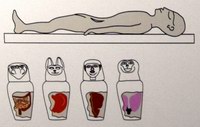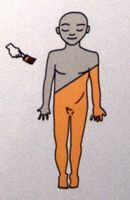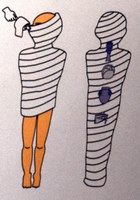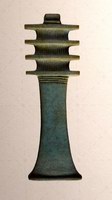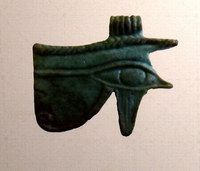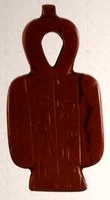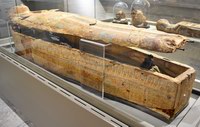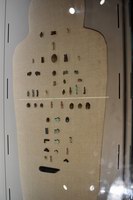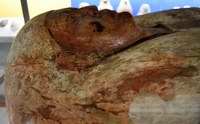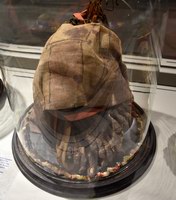Posiziona il mouse sulle immagini per avere più informazioni, sulle scritte evidenziate per altre informazioni.
LA MUMMIFICAZIONE
Uno dei requisiti per la sopravvivenza dopo la morte, nell’antico Egitto, era la conservazione del corpo e la sua identificazione con le membra del dio dei morti, Osiride, il cui cadavere, smembrato dal fratello Seth, fu ricomposto e riportato in vita dalla magia di Iside. Tale corpo perfetto permetteva agli aspetti spirituali del defunto, il ka e il ba, di vivere nell’aldilà e viaggiare liberamente tra il mondo dei vivi e il mondo dei morti. Sulla mummificazione possediamo informazioni soprattutto da Erodoto (V sec a. C.) che nelle sue Historiae descrive dettagliatamente i tre processi utilizzati dagli antichi Egiziani a seconda del loro status sociale, mentre nessun testo egiziano parla di tali procedure, ma solo dei rituali associati alla mummificazione (Papiro Rhind, 200 a.C.). Anche se i metodi di imbalsamazione cambiarono nel corso dei secoli, sappiamo che nella forma più elaborata il processo di mummificazione durava circa 70 giorni:
“Una buona sepoltura arriva in pace, i tuoi 70 giorni
sono stati eseguiti nel luogo d’imbalsamazione”
(Tomba Gehuty,Tebe,TT 110 )
Mummification
One of the prerequisites for life after death in ancient Egypt was the conservation of the body after death and transforming the lifeless body into a divine image with the features of a god. The mythological model of mummification was Osiris, whose body, dismembered by his brother Seth, was put back together and brought back to life by the magic worked by the goddess Isis. This perfect body allowed the spiritual aspects of the deceased, the ka and the ba, to live on in the afterlife and travel freely between the world of the living and the world of the dead. What written information we have about mummification we owe to classical authors, especially Herodotus (fifth century BC), who in his Historiae describes in detail the three processes of mummification used by the ancient Egyptians depending on their social status. No surviving Egyptian text provides comparable information, only the rituals associated with mummification (Papyrus Rhind, 200 BC). Although embalming methods changed over the centuries, we know that in its most elaborate form the mummification process lasted about 70 days;
A good burial arrives in peace, your 70 days
have been completed in the place of embalming
(Tomb of Djehuty, Thebes, TT 110)
1. LAVAGGIO DEL CORPO
Dopo la morte, il corpo veniva lavato in una tenda (ibu) e poi trasportato nella per nefer, dove avveniva la mummificazione.
Washing of the body
The corpse was initially washed in a tent ((ibu) and then brought to the per nefer where it was embalmed.
2. RIMOZIONE DEGLI ORGANI
Veniva praticato un taglio sul lato sinistro dell’addome, da cui venivano estratti tutti gli organi interni eccetto il cuore; questi erano trattati separatamente e poi posti all’interno dei vasi canopi oppure, a seconda delle epoche, ricollocati all’interno del corpo.
Removal of inner organs
A cut was made in the left side of the abdomen and all the internal organs, except for the heart, were extracted through it. These were embalmed separately and placed inside canopic jars (in some periods in Egyptian history, instead, the organs were put back inside the body).
3. DISIDRATAZIONE
Il corpo veniva ricoperto da uno spesso strato di natron, neceri, sale divino, per assorbire tutti i liquidi e permettere la disidratazione e 1’essiccamento del corpo.
Dehydration
The body was then covered with a thick layer of natron (netjiry, “divine salt”) to absorb all the liquids of the body, which was thus dehydrated and dried up.
4. RICOMPOSIZIONE DEL CORPO
Dopo circa 35 giorni il natron veniva rimosso e il corpo depurato e cosparso di oli profumati; i tagli venivano riempiti con sacchetti di segatura e lino e chiusi con resine.
Recomposition of the body
After about 35 days, the natron was removed and the body purified and aspersed with scented oils. The cuts were filled in with little bags of sawdust and linen and sealed with resins.
5. BENDAGGIO
Compiute tutte le fasi di essiccazione e pulizia, il corpo veniva avvolto in bende all’interno delle quali venivano posti gli amuleti e a volte anche una copia del Libro dei Morti.
Bandaging
After all the drying and cleansing phases had been completed, the body was wrapped in bandages, inside which amulets were placed, and sometimes a Book of the Dead papyrus.
I SARCOFAGI
All’interno della camera funeraria, il corpo dei defunti delle classi privilegiate era deposto in uno o più sarcofagi (fino a 7 nel caso del faraone).
Il sarcofago esterno (in legno o pietra) era in genere di forma parallelepipeda, talvolta con coperchio centinato e pilastrini ai quattro angoli.
I sarcofagi interni (anch’essi in legno o pietra) subiscono maggiori cambiamenti nel corso del tempo, sia nella forma sia nella decorazione. Sono originariamente rettangolari. Nel Medio Regno appare il sarcofago di forma antropoide, che ritrae il defunto come un “Osiride”, mummiforme con braccia incrociate sul petto. Nel Secondo Periodo Intermedio e nel Nuovo Regno questo tipo si sostituisce al sarcofago interno rettangolare. Nel Terzo Periodo Intermedio può essere mummiforme anche il sarcofago esterno. A partire dalla XXVI dinastia gli alti dignitari hanno sarcofagi antropoidi di grandi dimensioni magistralmente scolpiti in pietre molto dure, con base propria e pilastro dorsale. Quanto alla decorazione, nel corso della lunga storia egiziana si passa dalle casse non decorate dell’Antico Regno alle formule dette Testi dei Sarcofagi con rappresentazioni di offerte funerarie e occhi che permettevano al defunto di guardare fuori (nel Medio Regno), e poi a scene e formule funerarie legate alla religione solare e osiriaca nel Nuovo Regno, che diventano sempre più elaborate nel Terzo Periodo Intermedio.
Coffins
The body of a deceased of the well-to-do classes was placed in one or more coffins (up to seven in the case of kings) in the burial chamber.
The outer coffin made of wood or stone (in the latter case it is called a “sarcophagus”), was usually rectangular in shape, sometimes with a curved-topped lid and pillars at the four corners.
Inner coffins also made of wood or stone -changed more than outer coffins in the course of time, both in shape and in decoration. They were originally rectangular. In the Middle Kingdom, the anthropoid shape was introduced, picturing the deceased as a mummy-shaped “Osiris” with his or her hands crossed over the chest. In the Second Intermediate Period and the New Kingdom, this type replaced the rectangular inner coffin. In the Third Intermediate Period, the outer coffin can be mummiform, too. From the 26th Dynasty onward, high dignitaries have especially large anthropoid sarcophagi, exquisitely carved in very hard stone, with a back-pillar and feet resting on a plinth. As regards decoration, over the long course of Egyptian history there was an evolution from the undecorated coffins of the Old Kingdom to spells known as “Coffin Texts” accompanied by images of funerary offerings and eyes allowing the deceased to look outside, in the Middle Kingdom, and then on to scenes and religious spells relative to the solar and Osirian religion in the New Kingdom, which became increasingly elaborate in the Third Intermediate Period.
I MATERIALI E IL LORO SIMBOLISMO
Dopo la faïence, le pietre dure erano il materiale più utilizzato per la produzione di amuleti. Le materie prime provenivano principalmente dal deserto orientale, in alcuni casi dalla Nubia e perfino dall’Afghanistan. Ogni materiale aveva specifiche proprietà magiche, correlate al suo colore.
Materials and their symbolic meanings
After faïence, hard stones were the most often used material for the production of amulets. The raw matter mainly came from the eastern desert, in some cases from Nubia and Afghanistan. Each material had specific magical properties, correlated to its color.
LA FAÏENCE
Il materiale più utilizzato per gli amuleti era la faïence. Chiamata cehenet, “ciò che brilla”, era considerata una manifestazione della luce collegata alla risurrezione del sole. Si otteneva aggiungendo al silicio un alcalino (di solito il natron), calce, rame o altri pigmenti, e acqua per farne una pasta modellabile che veniva premuta in uno stampo della forma desiderata. Lo smalto era applicato prima della cottura o si formava per autovetrificazione durante la stessa.
Faïence
The most commonly used material for amulets was faïence. Called tjehenet, “that which gleams,” it was regarded as a manifestation of light connected to the resurrection of the sun. It was obtained by adding an alkaline (usually natron), lime, copper or other pigments, and water to obtain a pliable paste which was pressed in a mold of the desired shape. The glaze was applied before firing or was formed by a self-glazing process during the firing.
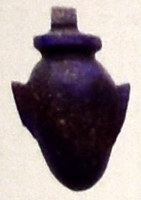
Lapislazzuli
Simbolo del cielo notturno.
Lapis Lazuli
was the symbol of the night sky.
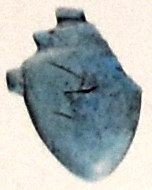
Turchese
Sinonimo di gioia e piacere.
Turquoise
was synonymous with joy and pleasure.
Ematite
Usata per specifici amuleti come il poggiatesta e la squadra.
Hematite
was used for specific amulets, such as the headrest and the square.
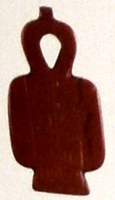
Diaspro Rosso
Simbolo di vita e degli aspetti positivi dell’universo legati al colore rosso.
Red Jasper
was a symbol of life and the positive aspects of the universe connected to the color red.
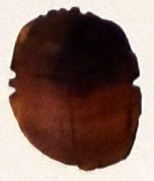
Cornalina
Dagli effetti benefici legati al sangue e al dinamismo universale.
Carnelian
had beneficial effects connected to blood and universal dynamism.
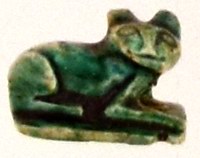
Steatite
Pietra tenera invetriata in verde, simbolo del rifiorire della vegetazione, della crescita e della fertilità, e quindi della resurrezione.
Steatite
a soft stone that was often glazed in green, symbolized the rebirth of vegetation, growth, fertility, and resurrection.
Amuleti Ged e Ugiat
Djed and Wedjat Amulets
Amuleto Pilastro Ged)
Rappresenta la colonna vertebrale di Osiride, come testimonia il capitolo CLV del Libro dei Morti. Era simbolo di stabilita e durata. Posto sul collo del defunto, assicurava il rinnovo della vita e la giovinezza. Di solito era realizzato in faience o in pietra dura.
Pillar amulet (djed)
It represents the backbone of Osiris, as borne out by chapter CLV of the Book of the Dead. It stands for stability and duration. Placed on the deceased's neck, it ensured the renewal of life and youth. It was usually made of faience or some hard stone.
Amuleto Ugiat
L'occhio della divinita. Ne esistono le versioni destra e sinistra, che rappresentano i due occhi di Horus, gli dei Ra e Osiride, la luna e il sole. Conferiva forza e salute.
Wedjat amulet
The eye of the god. It existed in right and left versions, which represent the eyes of Horus; the gods Re and Osiris; and the moon and the sun. It granted strength and health.
Amuleti Tit Disco Solare e Akhet
Tit Shen Akhet Amulets
Amuleto nodo d’Iside (Tit)
Simboleggia l’utero di Iside o un ornamento del suo abito. Assicurava l’aiuto delle arti magiche della dea e veniva comunemente costruito con materiali di colore rosso, come il diaspro o la cornalina.
Isis knot (Tit)
It symbolizes the womb of Isis or an ornament of her dress. It granted the support of the goddess’ magical arts and was commonly made of red-colored materials such as jasper or carnelian.
Amuleto Disco Solare
Amuleto nella forma del disco solare su una piccola base. Grazie a questo amuleto il defunto poteva sperare di unirsi al sole nel suo viaggio nel cielo e nell’aldilà per rinascere ogni mattina.
The Sun Disc Amulet
Amulet of the solar disk on a small base. It allowed to the deceased to join the sun in its journey through the sky and the Netherworld, to be reborn every morning.
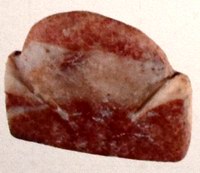
Amuleto Akhet
Sole che sorge all’orizzonte. Dava a colui che lo indossava calore e protezione in vita e resurrezione dopo la morte.
Akhet Amulet
Sun rising at horizon. It granted warmth and protection to whoever wore it in life, and resurrection after death.
|
|
|
|
|
|
|
|
Fotografie di Giorgio Manusakis



